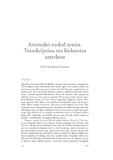Mostrar el registro sencillo del ítem
Artatzako euskal testua. Transkripzioa eta hizkuntza azterketa
| dc.creator | Salaberri Zaratiegi, Patxi | es_ES |
| dc.date.accessioned | 2017-11-21T09:10:27Z | |
| dc.date.available | 2017-11-21T09:10:27Z | |
| dc.date.issued | 2004 | |
| dc.identifier.issn | 0046-435X (Print) | |
| dc.identifier.issn | 2530-5832 (Electronic) | |
| dc.identifier.uri | https://hdl.handle.net/2454/26257 | |
| dc.description.abstract | En este artículo transcribimos primero el texto del zudairiarra Juan Vicente Díaz, vicario de Artatza durante largos años y hacemos después un análisis lingüístico del mismo. Para esto lo hemos comparado con los materiales que teníamos a nuestro alcance: en Navarra lo hemos comparado con el pequeño escrito de Eraul de 1564, con la doctrina de Elizalde, con los textos de Muzkiz y con los datos que conocemos de Burunda, y en Álava con los escritos de Lazarraga, Landuchio, Betolatza, García de Albéniz y Gámiz. La conclusión que sacamos es que el habla de Ameskoa Baja se encontraba en el cruce de los dialectos occidentales y navarro (meridional). | es_ES |
| dc.description.abstract | Artikulu honetan Artatzan urte luzetan bikario izandako Juan Vicente Diaz zudairiarraren testuaren transkripzioa eta hizkuntza azterketa egiten dugu. Bigarren eginkizunerako irispidean ditugun Ameskoaren inguruko testu eta materialekin alderatu dugu: Nafarroan Eraulgo 1564ko izkribu ttipiarekin, Elizalderen dotrinarekin, Muzkiko idazkiekin eta Burundako datuekin, eta Araban Lazarraga, Landuchio, Betolatza, Garzia de Albeniz eta Gamizen izkribuekin. Ateratzen dugun ondorioa da Ameskoabarreneko hizkera mendebaldekoaren eta (hego-)nafarreraren arteko bidegurutzean aurkitzen zela. | eu |
| dc.description.abstract | The present article consists of a transcription of the text by the “zudairiarra” Juan Vicente Díaz, for many years vicar of Artatza, followed by a linguistic analysis. This has been done by comparing the text with other material available to us: from Navarra, the short script of Eraul dating from 1564, the doctrine of Elizalde, the texts of Muzkiz and the information known to us about Burunda, and from Álava, the writings of Lazarraga, Landuchio, Betolatza, García de Albéniz and Gámiz. The article concludes that the speech from Améscoa Baja was at the crossroads between the Western and the Navarran (Southern) dialects. | en |
| dc.format.extent | 18 p. | |
| dc.format.mimetype | application/pdf | en |
| dc.language.iso | eus | en |
| dc.publisher | Gobierno de Navarra. Institución Príncipe de Viana | es_ES |
| dc.relation.ispartof | Fontes Linguae Vasconum, 97 (2004), 537-554 | es_ES |
| dc.rights | Creative Commons Attribution-NonCommercial 4.0 International (CC BY-NC 4.0) | en |
| dc.rights.uri | http://creativecommons.org/licenses/by-nc/4.0/ | |
| dc.subject | Díaz, Juan Vicente | es_ES |
| dc.subject | Euskera de Ameskoa Baja | es_ES |
| dc.title | Artatzako euskal testua. Transkripzioa eta hizkuntza azterketa | eu |
| dc.type | Artículo / Artikulua | es |
| dc.type | info:eu-repo/semantics/article | en |
| dc.contributor.department | Filología y Didáctica de la Lengua | es_ES |
| dc.contributor.department | Filologia eta Hizkuntzaren Didaktika | eu |
| dc.rights.accessRights | Acceso abierto / Sarbide irekia | es |
| dc.rights.accessRights | info:eu-repo/semantics/openAccess | en |
| dc.type.version | Versión publicada / Argitaratu den bertsioa | es |
| dc.type.version | info:eu-repo/semantics/publishedVersion | en |



